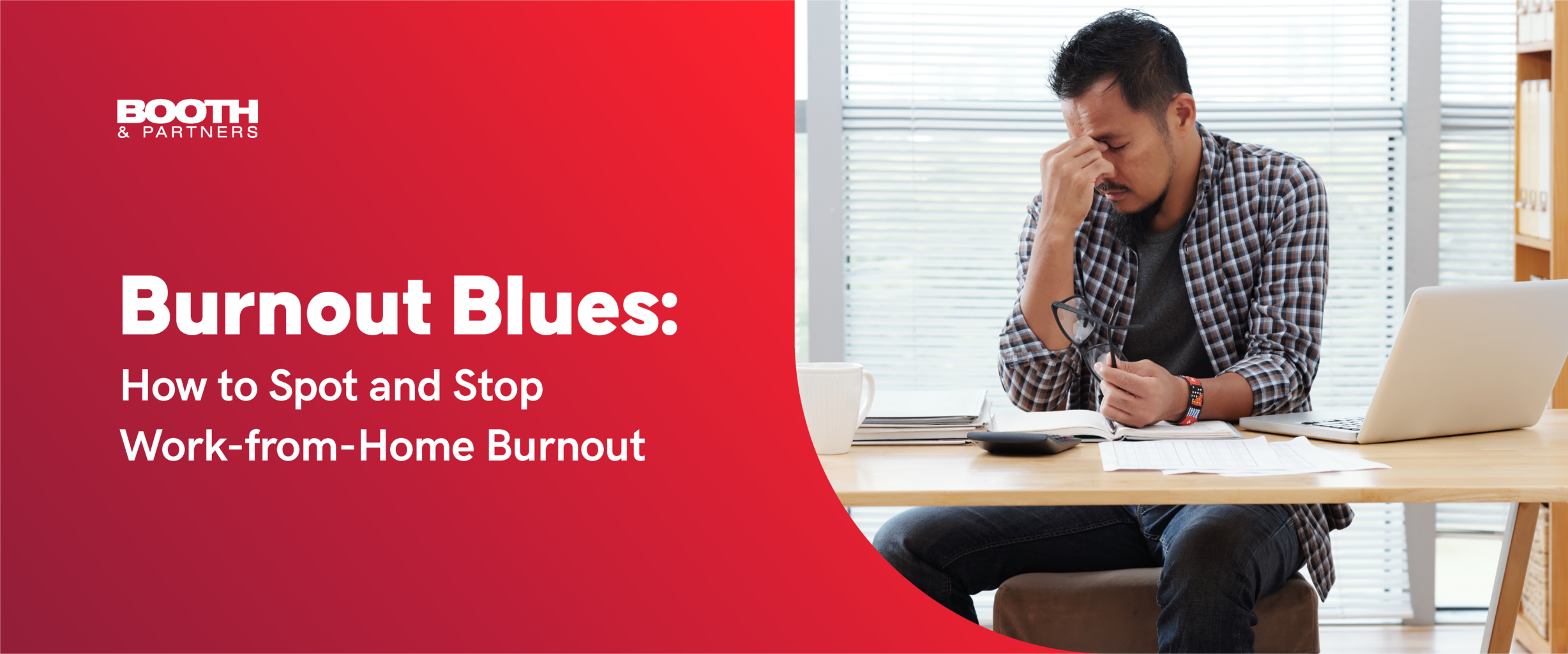Burnout Blues: How to Spot and Stop Work from Home Burnout

Millions of people from around the world have transitioned to remote work because of the Covid-19 pandemic. For many, being part of a remote team is a new if not a daunting realm; a new world with a lot of uncharted waters for employees. We may find that there are many challenges to working from home — one of these challenges being the quickly blurring lines between the personal space and the professional space. While some have managed to adjust, many have struggled to set healthy boundaries, which has resulted in growing numbers of employee burnout. You’ve probably heard friends and co-workers or even yourself saying it, “I’m burnt out!” Fortunately, there are helpful ways to spot and stop work from home burnout.
Some may find themselves working more hours to demonstrate their commitment to employers who may be concerned about their productivity while saddled with responsibilities from home. That’s why it’s more important than ever to foster healthy habits and use strategies to fight work from home burnout.
What is Work-From-Home Burnout?
Before we delve into the hows, we must first define what it is. The term “burnout” was a term coined in the 1970s by Herbert Freudenberger, an American psychologist.
Freudenberger defined burnout to be a “state of mental and physical exhaustion caused by one’s professional life”.
While the terms “stress” and “burnout” are sometimes used interchangeably, they are some key differences we need to address. For one, understand that stress can come from any event or thought that makes you feel frustrated, angry, or nervous. It is our body’s reaction to a challenge or demand. Burnout, however, is a response to prolonged and repeated stress that can leave you mentally and physically worn out, overwhelmed, emotionally drained, and unable to meet constant demands.
“The overarching feeling is scarcity of energy, motivation and purpose, and feeling like it won’t change.” – Lee Chambers, an environmental psychologist and well-being consultant in the U.K.
While stress is characterized by over-engagement or doing too much, burnout often leads to disengagement or not being able to do much. Burnout isn’t an entirely new concept, but there are many employees who are dealing with this new form of burnout from working at home due to the pandemic.
There are different strategies to nip remote-work burnout in the bud before it takes a toll on your career. I have outlined five of the main areas that contribute to work-from-home burnout, so you can properly address where your stress is coming from.
1. Workload
When the workload gets to be too much too often, workers feel overloaded. They lose opportunities for rest and professional growth, all while not getting enough work done. There is no balance between work and relaxation.
2. Community
The colleagues and clients (and the dynamic that a worker has with them) can severely affect morale. Burnout can be contagious — if one person is burnt out and doing nothing to make themselves feel better, then everyone around them can become susceptible to their lack of engagement.
3. Reward
When work is put in, a reward is to be expected. However, if the rewards, whether extrinsic or intrinsic, don’t match the amount of time and effort that were expended to get them, then most people are likely to feel that the investment is not worth it.
4. Perceived lack of control
Feeling powerless at work can take a toll. Those feeling like they lack autonomy or access to resources can experience low self-esteem and possibly depression, which can exacerbate the burnout that they are suffering.
5. Values mismatch
Everyone, even entities such as corporations and businesses, has values that they hold near and dear to their heart. If an employee’s values don’t match that of their employers’, their motivation and drive to work hard can drop.
How to Spot Burnout
Now that we have an understanding of what burnout is and some factors that can cause it, how do we spot it? What are the signs that someone is on the road to being burnt out?
1. Declining performance
When someone is feeling burnt out, the quality of their work goes down. If they are constantly late to meetings, making careless mistakes, or always procrastinating, then they are probably experiencing burnout.
2. Avoiding work
When someone is burnt out, they will want to do everything except work. Emails go unanswered and calls don’t get picked up. Duties pile up; the backlog gets bigger and bigger. This can overwhelm them and eventually lead to burnt out employees avoiding work even more. It’s a vicious cycle.
3. Inability to disconnect
One problem with remote work is that people find it difficult to unplug and disconnect. They feel like they always have to be available, even after office hours. More often than not, home-based employees work more hours than their office-bound counterparts. An employer wondering how to manage a remote team has to encourage their employees to disconnect every once in a while to avoid burnout.
4. Exhaustion or apathy
The simple truth about burnt out employees is this: they just don’t care anymore. They don’t feel motivated. They’re detached from their responsibilities. They’re unresponsive during both casual conversations and important meetings. They don’t care, and if there’s no intervention, that apathy can lead to burnout.
How to Deal with Burnout
Fortunately, burnout isn’t a terminal condition. It can be cured when dealt with swiftly, kindly, and empathetically. So, the big question is: how can we avoid burnout at work? Here are some ways.
1. Maintain boundaries
Structure and routine are an inherent component of an office-based job. It’s so ingrained that a common synonym for “job” is “nine-to-five” — the start and end of the usual eight-hour workday. But for those working at home, that boundary is blurred; more often than not, there is nothing to signify the beginning and end of a shift.
The strongest deterrent to burnout is well-defined boundaries. Employers and employees alike have to set clear office hours and use rituals to start and end their workday. It is also important to understand what ca Some rituals before work can be showering, making coffee, or planning a daily to-do list. To end the workday, one can close all work devices and clean up the workspace.
2. Focus on the most important duties
Working from home is not the time for “busy work” — work that keeps one occupied but is not that vital. Employees might feel like they have to constantly show how productive they are by working on small, inconsequential tasks that fill up the productivity tracker when there are bigger, more important duties to be done. Burnout can be avoided by putting all of one’s focus on the most important tasks first.
3. Reframe the way you look at work
Quitting the job is the most effective cure for burnout. However, not everyone can just up and leave. Those who are stuck in a rut, slowly inching their way to burnout, need to reevaluate the state of their mind regarding their careers instead. They must find some value in their work, no matter how dull or mundane, and discover what aspects they enjoy and take pleasure and pride in. Having strong friendships at work can also help, as will taking some time off when burnout feels inevitable. The time away would help clear the mind and pursue rest and relaxation. After a good break, most people come back to work refreshed and ready, no longer burnt out.
4. Reevaluate your priorities
Burnout is a condition that arises when something is wrong and unbalanced. Avoid burnout by thinking about the important things: what are your hopes, dreams, or goals? Take some time to reflect, heal, and rediscover what truly matters. Reevaluating priorities can make someone find out what truly makes them happy, what keeps them balanced. When people are content and have clear plans for self-improvement, they can handle burnout better than others.
5. Communicate your issues
Without the personal interactions in the office, it is more difficult for your colleagues to pick up and notice your behavioural changes. It is your job to be aware of your shifts in behaviour and speak to it with others. If you think the workload and the time you employ at work is the main factor for your burnout, you can communicate this tactfully to your manager or supervisor. You may want to express your concern in a tactful and positive way: “I want to be able to do my best work and would like to discuss with you ways on how I can remain efficient and engaged while working from home.” This will definitely be understood in a positive light and show your fully committed and want to be in your best condition. Once the conversation is open, you can now discuss what is and what is not working for in your current workplace situation. You can also look into ways on how to improve remote team collaboration to address your workflow issues.
When someone is burnt out, they may find it difficult to care, not only about their work, but also themselves. They see nothing but a bleak, lonely, endless slog, which can lead to isolation and depression. The best way to handle this is to reach out to people who you feel can help you. Stress can easily melt away when in the company of family and friends who genuinely care and want to listen. When someone is on the verge of burnout, reaching out and finding people who care can truly help alleviate the stress.
Employers can also help lessen the number of burnt out employees by considering outsourcing or Staff Leasing or Managed Services when work volumes are up. In the Philippines, there are many remote teams that can take on the excess workload. Your offshore team may be a good solution to ameliorate the growing number of employees who are burnt out and there are other distinct benefits of having your own remote team for your business.
These days, balance between life and work is difficult to achieve. When burnout is at bay, remember to take a step back, breathe, and deal with it as soon as you can. By knowing the cause, recognizing the red flags, and taking care of yourselves, you can come out on top, feeling rejuvenated and renewed, ready to get back to work.
Discover more about outsourcing and
how you can maximize it for your
business success!
Get a copy of our E-book: Guide to Outsourcing.




